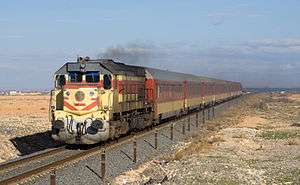EMD GT26CW-2
|
ONCF class DH 370 | |||||||||||||||||||||||||||||||
| |||||||||||||||||||||||||||||||
| |||||||||||||||||||||||||||||||
| |||||||||||||||||||||||||||||||
| |||||||||||||||||||||||||||||||
The GT26CW-2 is a diesel-electric locomotive modified type of GT26CW created by the Electro-Motive Division of General Motors for export in Iran, Israel, Morocco, Pakistan, Peru, South Korea, Turkey and Yugoslavia. Various licencees have constructed this model.
Iran
The Islamic Republic of Iran Railways (RAI) purchased 80 GT26CW-2s along with 182 GT26CWs . All GT26CW locomotives were manufactured by General Motors Diesel Division of Chicago ,Illinois, 20 GT26CW-2s were constructed by General Motors Diesel Division of London, Ontario and the remaining were built by Hyundai, a Korean licencee of General Motors Diesel Division. Out of 262 GT26CW locomotives, 180 units are currently in revenue service. All RAI locomotives have three 48 inch fans instead of 2 which is a necessary provision for hot climate of Iran.
Peru
The Empresa Nacional de Ferrocarriles del Peru (Enafer) operates seven GT26CW-2s for the mining region. All were constructed by General Motors Diesel Division of London, Ontario.
South Korea
From December 1989 to October 2000, the Korean National Railroad received GT26CW-2s from Electro-Motive Division and Hyundai Rolling Stock Co. (present:Hyundai Rotem) The locomotives are used for freight service, Mugunghwa passenger trains, Saemaul passenger trains, and excursion trains (G-Train, S-Train, and the Haerang). on all Korail lines, though some are currently owned by the Korea Rail Network Authority.
Very little is known about their construction. However, it is known that 83 units were constructed between December 1989 and October 1996 as the 7300-series, 41 were constructed between December 1996 and May 1998 as 7400-series units 7401-7414 and 7500-series units 7557-7583, and 70 units were constructed between November 1998 and October 2000 as 7400-series units 7415-7484.
Turkey
The Turkish State Railways received 89 units built by Tülomsaş between 2003-2009. The units are numbered TCDD DE33000. They have the latest innovations of the GT26 series, mainly noticed by a spacier cab view.
Yugoslavia
The Yugoslav Railways (Jugoslavenske Željeznice) received 14 GM GT26CW-2s from EMD. Mainly used for freight and passenger trains between Knin and Split (Dalmatinska pruga, today part of M604 railway (Croatia)). All locomotives went to service on Hrvatske Željeznice after the breakup of Yugoslavia in 1991. They are now classified as HŽ series 2063. In the meanwhile, some were sold to NREC.
Pictures
 Israel Railways GT26CW-2
Israel Railways GT26CW-2 Korail 7432
Korail 7432 Croatian 2063 series locomotive
Croatian 2063 series locomotive
See also
- EMD SD40-2, a similar locomotive for North American loading gauge
- List of GM-EMD locomotives
- List of GMD Locomotives
Sources
- 2063 at zeljeznice.net (in Croatian)
- GT26CW at trainweb.org
- TCDD DE 33000 at tulomsas.com.tr
- TCDD DE 33000 at tulomsas.com.tr (in Turkish)

